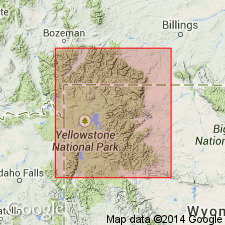
- Usage in publication:
-
- Langford Formation*
- Modifications:
-
- Named
- Dominant lithology:
-
- Volcaniclastics
- AAPG geologic province:
-
- Yellowstone province
- Montana folded belt
Summary:
Named as the basal formation of Thorofare Creek Group (new) of Absaroka Volcanic Supergroup (new). Source of name and type area is Mount Langford, Yellowstone National Park, Yellowstone province, WY. Extends north of Park into Montana folded belt province, MT. Includes light-colored andesitic volcaniclastic strata and lava flows, and alluvial facies. The volcaniclastic rocks are composed of hornblende and pyroxene andesite fragments. The light color is attributed to the light-gray ash-rich matrix. The vent center is near the east border of the Park near Eagle Peak where Langford includes dark vent facies, lava flows, flow breccias, and agglomerate. Is 2,000 ft thick at type. Is thickest in southeast part of Park. Extends to southwest edge of Absaroka field. Its extent east of field is unknown. Name Promontory Member applied to several eastward-thinning tongues of dark, massive volcanic conglomerate in upper part of formation. Unconformably overlies Mount Wallace Formation (new); is overlain unconformably by Two Ocean Formation (new) of Thorofare Creek Group. Considered to be early middle Eocene age on basis of stratigraphic position.
Source: GNU records (USGS DDS-6; Denver GNULEX).
For more information, please contact Nancy Stamm, Geologic Names Committee Secretary.
Asterisk (*) indicates published by U.S. Geological Survey authors.
"No current usage" (†) implies that a name has been abandoned or has fallen into disuse. Former usage and, if known, replacement name given in parentheses ( ).
Slash (/) indicates name conflicts with nomenclatural guidelines (CSN, 1933; ACSN, 1961, 1970; NACSN, 1983, 2005, 2021). May be explained within brackets ([ ]).

